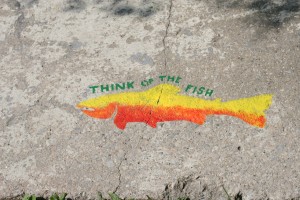Just finished a summer institute for teachers in Toronto that took an integrated approach environmental education (EE) and ecological literacy by using art, science, outdoor ed and mapping as a way to get teachers and students outside to learn about the environment. What a great time! Hosted by Evergreen (an amazing Canadian EE non-profit) and the EE dept. at the Toronto District School Board, about 30 teachers came to Runnymede PS in the west end of the city for four days of tours, learning activities, and stimulating discussions, all centred on EE. I was lucky to work with co-facilitator and science educator extraordinaire Pam Miller (for the fourth summer in a row), new Evergreen staffer Erin Wood, as well as four inspiring lead teachers from schools around the city – Anne Lakoff, Karen Goodfellow, Ryan Adams and Jennet Poffenroth.
We organized the institute on learning in, about and for the environment, themes drawn from the TDSBãs approach to developing studentsã ecoliteracy. We combined this with a focus on learning trails, a type of guided learning experience that gets teachers and students outside to access the range of environments in their communities. We modeled interpretative, self-guided and investigative trails, and then had the teachers develop their own for the upcoming school year.
Of course there was a strong art component to this institute as we encouraged teachers to experiment with age-appropriate environmental action with their students. Part of this was manifested via creative approaches to mapping, but a few of us also played with developing the Yellow Fish Road concept to make it more eye-catching. Here is the result of our efforts ã a stenciled fish near the Humber River that reminds people of the rich range of life in our rivers and lakes in the city.
Overall it was a wonderful week of PD for all of us as the teacher-participants always end up teaching us just as much as we teach them. Iãm hoping some of the ideas from the institute take on a life of their own in schools across Toronto over the course of the school year.
Hilary

